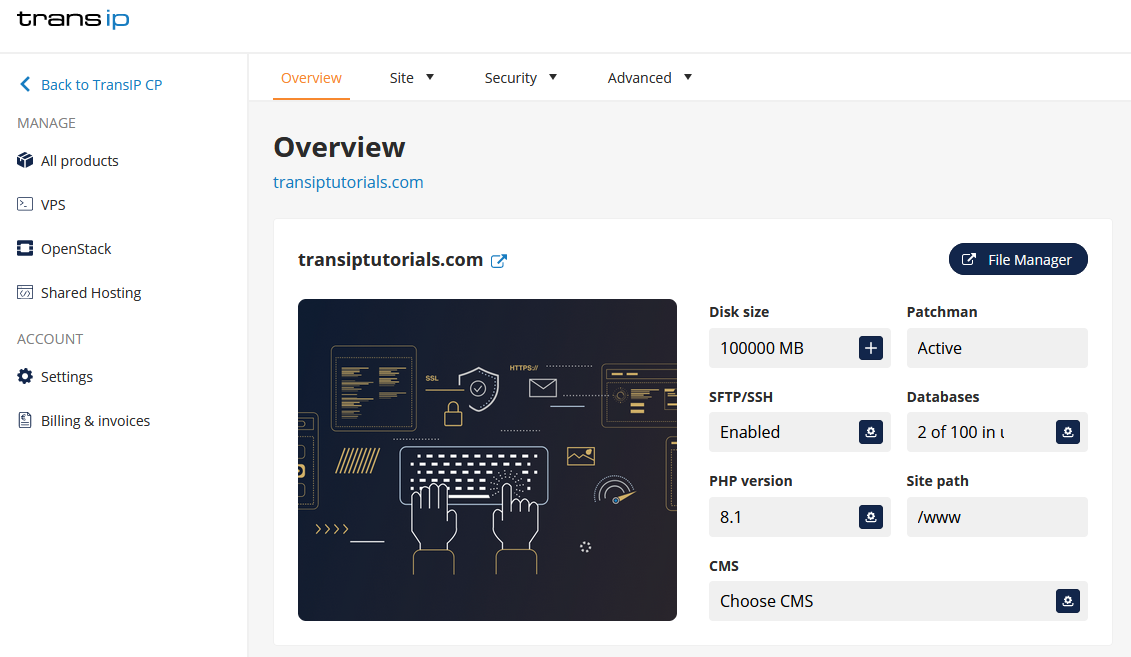If you make a habit out of regularly updating your website, the upgrade to a new PHP version should not cause any difficulties. However, it can happen that your website is not displayed correctly after changing the PHP version. You might see an 'Internal Server Error' or a white page when this happens. This means that a part of your website is outdated and uses a feature that is no longer usable with the newer PHP-version.
In this article we show you how to get your WordPress and Joomla! website working like it should after updating to PHP 8.0, or higher. If you use a Magento website or a custom website you built yourself, we recommend consulting the online documentation for troubleshooting.
Take note: We currently support PHP versions 8.0, 8.1, 8.2, 8,3, and 8.4.
Update your website
When your website is unavailable when using PHP 8.0 or higher, we recommend updating your website and any installed plugins (WordPress). You should first try to log on to the Dashboard of your website. If the Dashboard is still available, you will be able to make the updates in here.
Check your Error Log
If updating your website and its plugins and extensions did not help, we recommend checking the Error Log.
Log in to the control panel and click 'Shared Hosting' in the menu. Next, select your domain below 'Products'.

In the overview, click 'File Manager' in the top right.

Open the 'logs' folder and open the error.log file. You will now see an overview with errors present on your website. Take note that not all errors demand immediate attention. In this case you are looking for errors containing 'stderr'.
99% of the time, the 'stderr' error lets you know that your website or a part of it is incompatible with PHP 8.0 or higher.

In the image shown above you can see that a part of the WordPress plugin WooCommerce is deprecated. This means that the specific part is outdated and requires an update. In this case you will not have to dig in the code of your website. An update of the plugin WooCommerce will suffice.
When there is no update present for the plugin or extension causing the problems, it may be required to edit the code of your website.
Take note that we do not offer direct support on configuring your website or its code. In this situation we recommend troubleshooting these error messages yourself or let a website builder do it for you.
If no website builder is available, we may be able to give you advice. In that case, contact our support using the 'Contact' button in your control panel and send the error message you're having trouble with.
Manually check your plugins
In most cases, following the above-mentioned steps will be sufficient to get your WordPress or Joomla! website to work again. In some cases you may still see that your WordPress website isn't working, even though the Error Log doesn't show anything (useful). You will usually see a blank page if that's the case.
This means that one or more plugins are causing trouble. To troubleshoot this, we recommend logging on to your WordPress Dashboard and disabling all of your plugins. Next, enable the plugins one by one and check your website after each action.
If your WordPress Dashboard is not available, open 'File Manager' in your control panel. From here, navigate to the 'www' folder, followed by the 'wp-content' folder and lastly the 'plugins' folder. Here you will find a list of your installed plugins.
Rename the folder of the plugin that is causing trouble, adding an underscore in front of the name of the plugin. Once you've done this, the plugin is disabled and you should be able to log on to your WordPress Dashboard once more.
Next, update the plugin via the Dashboard to see if this makes your website available again. If that is not the case, delete the plugin and search for an alternative plugin to use.
This can also apply to the theme that you're using. In that case, try disabling your theme and repeat the steps above.
Custom PHP website
It's possible you've built your own PHP website, in stead of using WordPress or Joomla!. In that case we cannot offer direct support on troubleshooting this website, but there are several PHP tutorials to help you getting your website running on a higher PHP version:
- If your website was running on PHP 7.4 and you wish to go to PHP 8.0, you can use this article.
- If your website was running on PHP 8.0 and you wish to go to PHP 8.1, you can use this article.
- If your website was running on PHP 8.1 and you wish to go to PHP 8.2, you can use this article.
- If your website was running on PHP 8.2 and you wish to go to PHP 8.3, you can use this article.
- If your website was running on PHP 8.3 and you wish to go to PHP 8.4, you can use this article.




